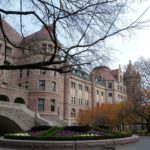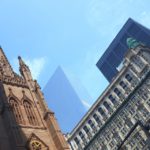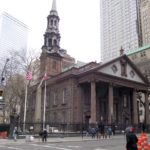Jutting off the western edge of the Financial District in Lower Manhattan, Battery Park City is one of New York City’s newest neighborhoods. A mixed-use enclave named for the nearby Battery Park, Battery Park City is unique among the city’s neighborhoods as it was built only recently and exists on top of a massive landfill that reshaped the Manhattan shoreline. Although a popular place to live, work and visit, few know the hidden history of this unique community. Here a quick look at how this vibrant mixed-use district was created.
The area that today contains Battery Park City was once a thriving dockyard for much of the city’s history. In the late 1950s, however, the docks had fallen into steep decline as containerization and commercial air transportation made them increasingly obsolete. To counteract this and revitalize the area, a landfill was proposed to create a new mixed-use district to inject new life into the declining docklands of Lower Manhattan in the early 1960s. A master plan was created by architect Wallace K. Harrison, calling for a mix of residential, commercial and public space, making for an entirely new community in Manhattan. The Battery Park City Authority was created by the New York State Legislature in 1968 to oversee the new development, which was finalized the following year.
Construction on the landfill began in the early 1970s, often using dirt from excavated from the nearby World Trade Center megaproject. The landfill was completed in 1976 and construction of the new neighborhood itself began in earnest in the summer of 1980. The neighborhood was largely completed in the 1980s and the 1990s, attracting workers from Wall Street nearby and families looking for a convenient place to live downtown. The centerpiece of the new development, the World Financial Center, was also completed in the 1980s.
Like much of Lower Manhattan, the neighborhood was hit hard by the September 11th attacks but steadily recovered and transformed itself into a more desirable, upscale location. The completion of a new ferry terminal in 2009 and the renovation of the World Financial Center into the trendy new Brookfield Place helped to usher in a new era for the community, solidifying its status as one of Lower Manhattan’s premier places to visit, work and live.
Today, the community stands as one of Manhattan’s most desirable neighborhoods. It’s hard to believe that just a few decades ago, its vibrant streets and towering skyscrapers were once the site of dilapidated cargo docks!






